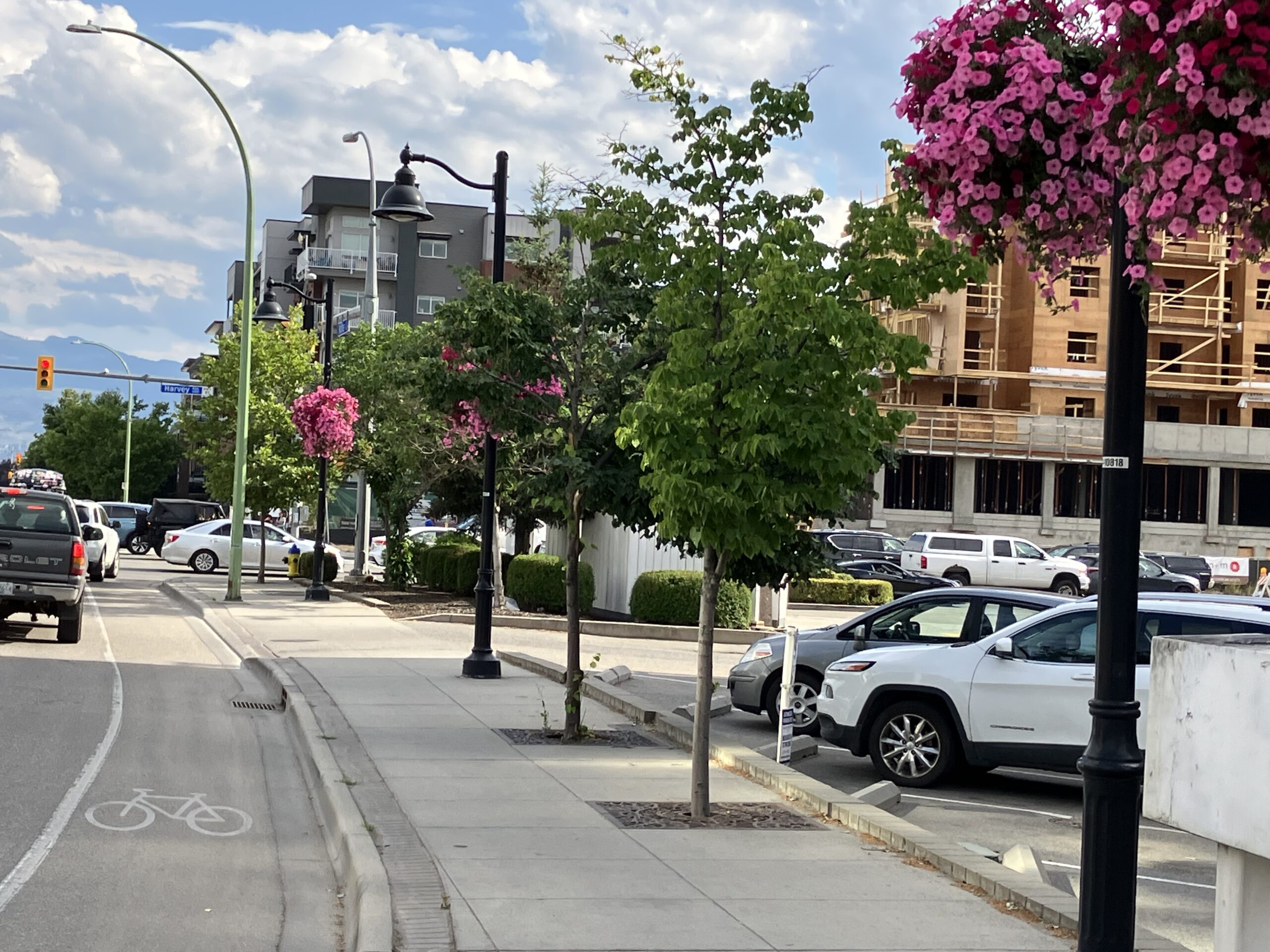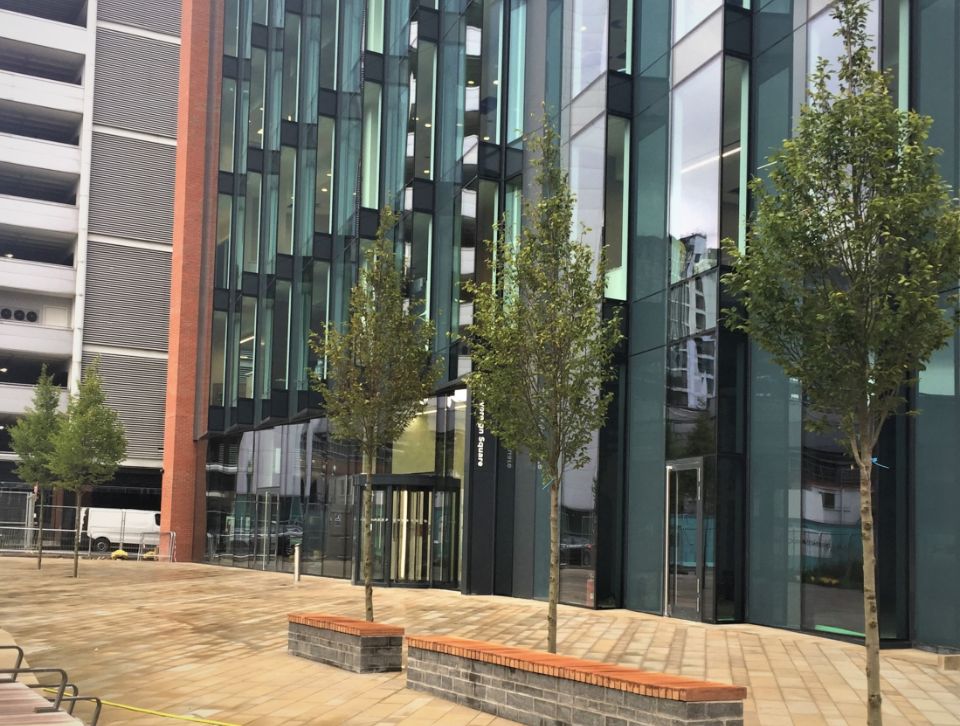Today, the importance of soil volume is a given — thanks in no small measure to industry-forward projects like this one

Despite some drought stress, the Silva Cell trees planted along Richter Street are all alive sixteen years after installation
In the early 2000s, the standard 4×4 tree pit — and, to a lesser extent, structural soil — was the preferred tree-planting strategy under city hardscapes. Supporting the weight of sidewalks, parking lots, and roadways was the chief concern of urban planners, with soil (and thus, the ultimate health of the tree) as a secondary priority.
The DeepRoot Silva Cell system, the first of its kind, revolutionized the market with its ability to suspend the pavement while simultaneously creating a void-space environment for uncompacted loam soil. The best of both worlds. It was still, however, an unproven concept when in 2007 the first commercial Silva Cell installation took place in Kelowna, British Columbia, along a half-mile stretch of Richter Street where a comparative test was performed with Silva Cells, structural soil, and traditional tree pits.
The inaugural real-world application for any new product is certainly a learning experience. Let’s look back more than a decade and a half to the first Silva Cell install and examine the details of the project, how the trees are performing, and what lessons were learned (hint: soil volume, soil volume, soil volume).
Planting a tree in a 4×4 tree pit, without access to adequate soil volume, is not economical. You can see these Kelowna tree-pit trees are on their second or third planting in fifteen years.
-Michael James, DeepRoot General Manager

Silva Cell trees on Richter Street
Growing large, mature trees in urban areas has always been a challenge. With numerous priorities competing for the same space — both at surface level and below ground — sacrifices were inevitable. And, for a long time, the health of the tree was among the lowest priorities on the list.
Over time, however, the value of green infrastructure (and urban forestry in particular) became more widely understood — and the standard 4×4 tree pit, known colloquially as the “tree coffin” for its inhospitable root-growing conditions, wasn’t cutting it. The concrete basins were expensive and inflexible, to say nothing of their trees’ correspondingly high death rate. Something had to change.
So, why Kelowna? The answer has a lot to do with Ian Wilson, Urban Forestry Supervisor for the City of Kelowna in 2007. Working closely with the ISA (International Society of Arboriculture) and spurred by a desire to see “downtown trees do better,” Wilson had heard about the new Silva Cell suspended pavement technology — and an upcoming downtown project presented an opportunity:
We really wanted to try the new product but it hadn’t been ‘field tested’ yet. We had an opportunity where some downtown sidewalks were getting redeveloped [and] we decided to try out three different treatments: one block with Silva Cells, one with structural soil, and the third with tree pits, to see how they compared with costs and also long-term tree performance. We also wanted to get the engineers and others more comfortable with this new technology.
Wilson worked with DeepRoot General Manager Michael James to craft the details of the experiment. The west side of a three-block stretch of Richter Street, from Bernard Avenue to Harvey Avenue, was slated for sidewalk renovation in the spring of 2007. The streetscape tree-growing demonstration unfolded as follows:
One of the most important issues facing project planners was exactly how much of a difference soil volume access makes regarding the health of a newly planted tree.
It was pretty obvious within a short time that the structural soils and the Silva Cells were doing much better than the tree pits
-Ian Wilson, former Urban Forestry Supervisor for the City of Kelowna

The tree-pit trees, on their second or third planting after many of the original trees died, are small and frail
All of the trees were planted along Richter Street at the same time, during the spring and summer of 2007. Despite being the first commercial Silva Cell installation, operations went smoothly (with a few lessons learned, discussed in the following section). Monitoring of the trees’ performance was paramount, and a report was conducted three years hence, in the summer of 2010, documenting the growth of each tree-growing strategy:

The tree-pit trees showed very little growth, while those planted in structural soil and Silva Cells were displaying great early promise. The following years would follow a similar pattern, with structural soil and Silva Cell trees seriously outperforming those planted in the 4×4 pits. By the summer of 2023, sixteen years after installation, the tree-pit plantings could unofficially be declared the “loser” of the experiment: many trees were already on their second or third iteration, given the death of their predecessors, and those that remained were small and frail.
A more interesting comparison is found between the structural soil trees and those in Silva Cells. The trees utilizing these soil strategies look far more similar to one another: they’re noticeably larger and healthier than their tree-pit counterparts. Trees on both streets are suffering from some drought stress (Kelowna is a very dry area, a constant concern for regional arborists). Indeed, one clear distinction between these trees is their irrigation needs: the loam soil found in the Silva Cells retains water far more successfully than does structural soil, whose rocky composition guarantees quick movement of water through its column. This translates to a costlier irrigation bill for trees planted in structural soil.
Likewise, while the average size of the structural soil trees and the Silva Cell trees is comparable, one or two structural soil trees have already died (whereas all the Silva Cell trees are original plantings). It’s important in this regard to point out the difference in available soil volume for each strategy, as identified by Ian Wilson at the time of installation:

The difference in accessible soil volume is stark, with Silva Cells providing four times as much soil in the same square-meter area than the engineered soil trenches (structural soil). Depriving tree roots the soil to expand is to deprive the tree itself of nutrition, health, and vitality. As we’ve since learned, five cubic meters (while significantly more than its counterparts in this exercise) is not nearly adequate for truly flourishing growth. More on this below.
There is also a noticeable cost difference. While Silva Cells are a more expensive front-end choice, the per-cubic-meter price of actual soil volume is substantially lower. In fact, the per-cubic-meter price of soil volume for structural soil or standard tree pits is nearly three times as much as Silva Cells (in 2007 dollars). And, because trees provide virtually no value to the community until they become large and mature — to say nothing of the added cost of regularly replanting dead trees — the investment in Silva Cells pays for itself in the long run. Likewise, the Silva Cell system has become more affordable since this first project, with an even lower per-cubic-meter of soil volume cost.
You have to use a lot more water in the soil column of structural soil, because it has little ability to retain it. Trees are much more susceptible to drought stress in structural soil than in Silva Cells.
-Michael James, DeepRoot General Manager

Though many of the structural soil trees did show promising growth, one of them has since died
Some fundamental lessons were of course learned during the first-ever commercial Silva Cell installation: zip ties weren’t strong enough to hold the system in place, for instance. Cable ties were instead needed. Also, the modularity of the Silva Cell system, as suspected during the design process, did provide field versatility around existing utilities.
In retrospect, the Kelowna project should be considered a qualified success. The Silva Cell trees performed better than other strategies, if similar in growth to the structural soil trees — though, importantly, no trees planted in Silva Cells died and their irrigation requirements remain far more moderate. Still, these trees may’ve already reached their maximum growth potential. Why? The soil volume environment, while more robust than that found in tree pits or structural soil, is still far too limited to ensure size and longevity.
Over a decade and a half later and the question of soil volume’s importance in growing large, healthy trees is all but unanimous. But it’s critical to remember that this wasn’t always the case: experiments like this helped set the stage, providing early quantifiable evidence of the correlation between soil volume and healthy tree growth. The City of Kelowna took this lesson to heart: shortly after the Richter Street project, the city instituted a minimum soil volume mandate for all new trees, requiring each one to have access to 10 cubic meters of soil. This has since been updated to 25 cubic meters, a true demonstration of Kelowna’s dedication to urban green spaces, prompted in no small measure by this first-ever Silva Cell installation.
